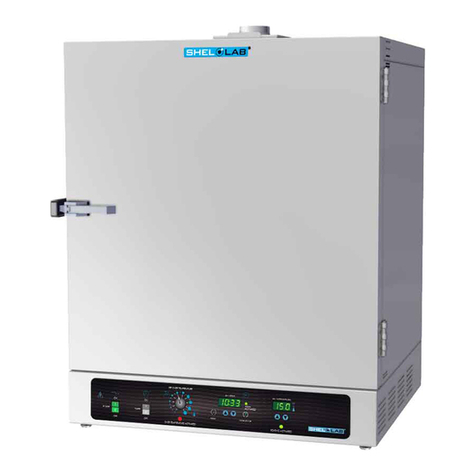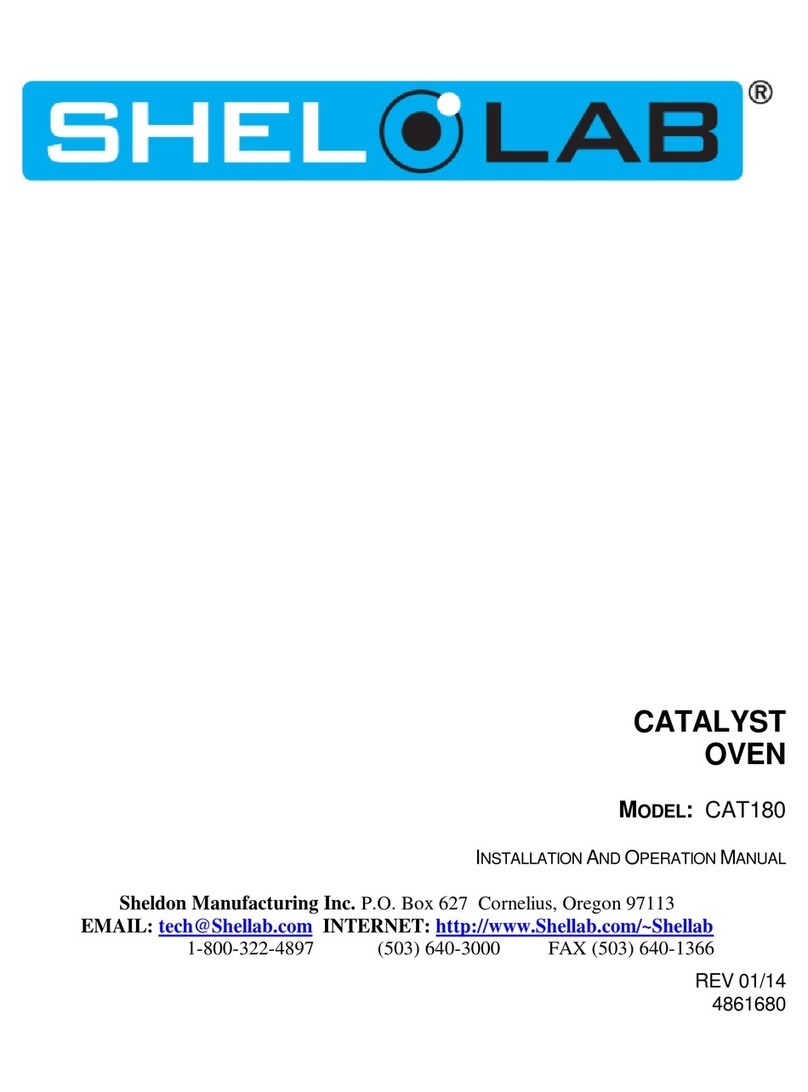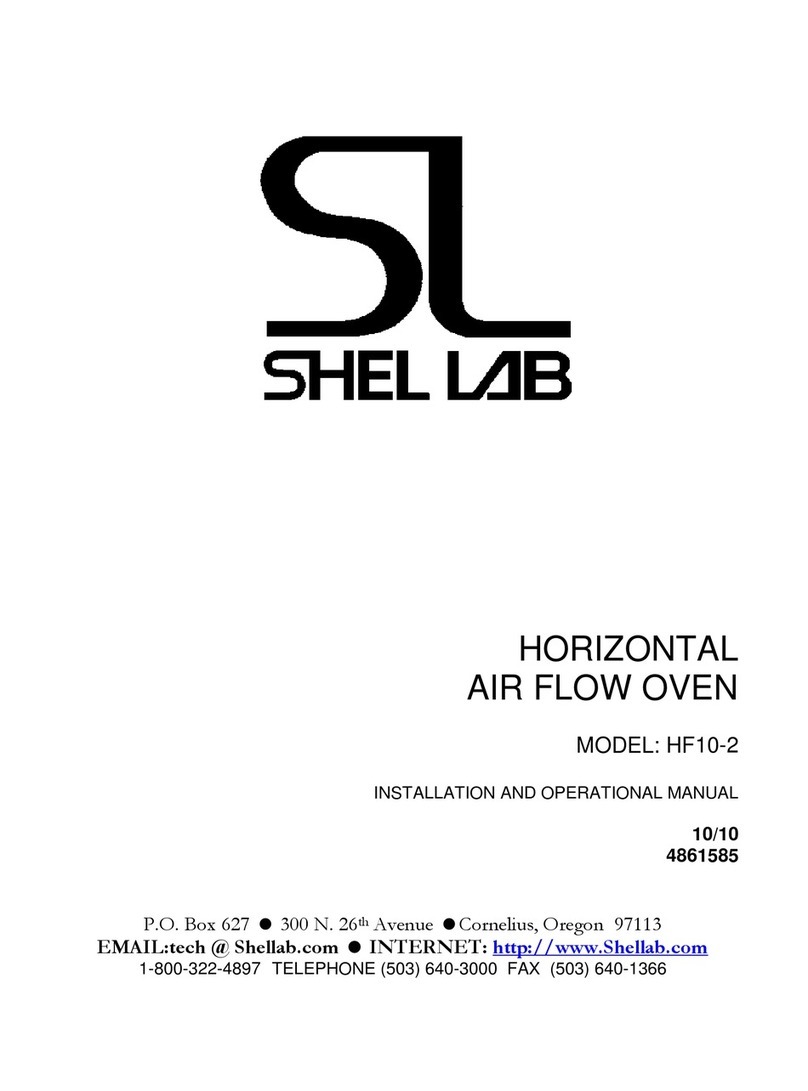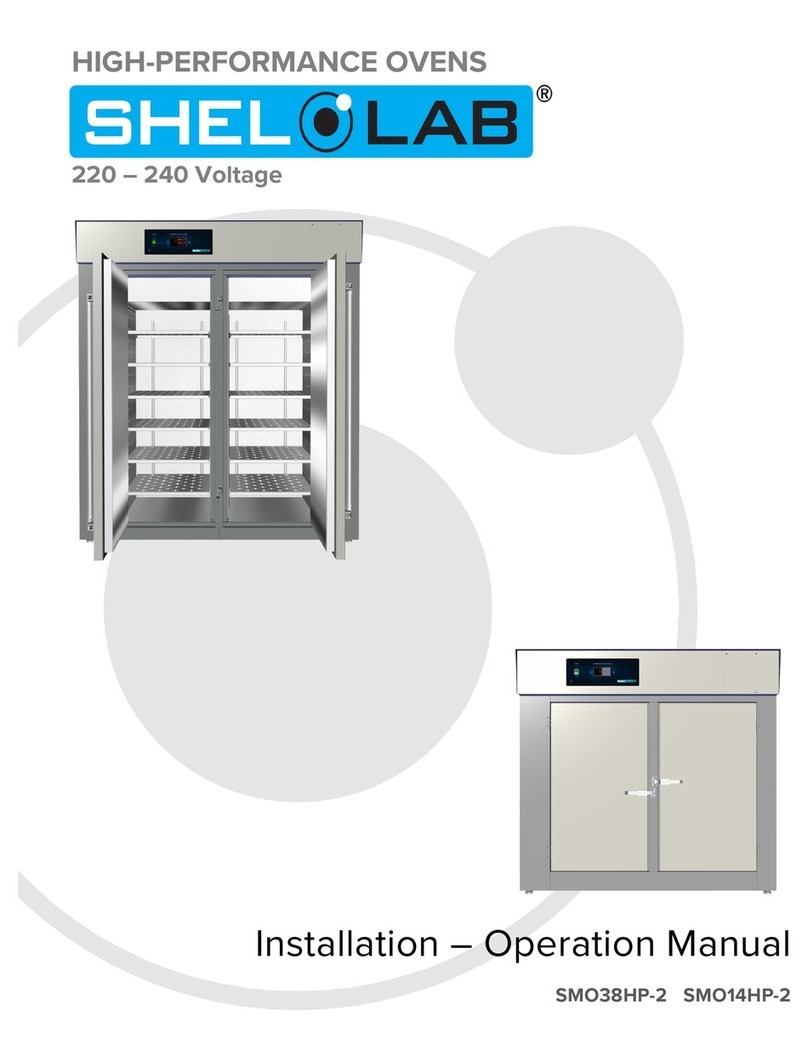Shel lab SMO38HP-2 User manual

Installation – Operation Manual
SMO38HP-2 SMO14HP-2
HIGH-PERFORMANCE OVENS
220 – 240 Voltage

2 | Page
These ovens require permanent connect wiring (also known as hardwiring) to a single-phase power
supply.
Pictured on front cover: SMO38HP-2 (left) and SMO14HP-2 (right)

3 | Page
SMO High-Performance Ovens 220 – 240 Voltage
Part number (Manual): 4861705
Revision: December 12, 2018
SHEL LAB is a brand of Sheldon Manufacturing, INC, an ISO 9001
certified manufacturer.
Safety Certifications
These units are CUE listed by TÜV SÜD as forced air ovens for professional, industrial, or educational use
where the preparation or testing of materials is done at an ambient air pressure range of 22.14 – 31.3 inHg
(75 – 106 kPa) and no flammable, volatile, or combustible materials are being heated.
The units have been tested to the following requirements:
CAN/CSA-22.2 No. 61010-1:2012
CAN/CSA-C22.2 No. 61010-2-010:2015
UL 61010-1:2012
UL 61010-2-010:2015
EN 61010-1:2010
EN 61010-2-010:2014

4 | Page
TABLE OF CONTENTS
INTRODUCTION........................................................................................................................................... 5
Read this Manual ...................................................................................................................................... 5
Safety Considerations and Requirements ................................................................................................ 5
Contacting Assistance............................................................................................................................... 6
Manufacturing Warranty ............................................................................................................................ 6
Engineering Improvements ....................................................................................................................... 6
Reference Sensor Device ......................................................................................................................... 7
RECEIVING YOUR OVEN ............................................................................................................................ 9
Inspect the Shipment ................................................................................................................................ 9
Orientation Images .................................................................................................................................. 10
Recording Data Plate Information ........................................................................................................... 12
INSTALLATION .......................................................................................................................................... 13
Hardwire Requirement ............................................................................................................................ 13
Installation Checklist ............................................................................................................................... 13
Required Ambient Conditions ................................................................................................................. 14
Required Clearances .............................................................................................................................. 14
Power Source Requirements .................................................................................................................. 15
Power Feed Wiring.................................................................................................................................. 16
Lifting and Handling ................................................................................................................................ 16
Removing from the Pallet ........................................................................................................................ 16
Leveling ................................................................................................................................................... 17
Install the Oven ....................................................................................................................................... 17
Installation Cleaning ................................................................................................................................ 17
Install the Shelving .................................................................................................................................. 18
GRAPHIC SYMBOLS................................................................................................................................. 19
CONTROL OVERVIEW .............................................................................................................................. 21
OPERATION ............................................................................................................................................... 23
Operating Precautions ............................................................................................................................ 23
Theory of Operations .............................................................................................................................. 24
Put the Oven into Operation.................................................................................................................... 26
Set the Over Temperature Limit.............................................................................................................. 27
Over Temperature Limit Activation.......................................................................................................... 28
Set the Constant Temperature Set Point ................................................................................................ 29
Heating Profiles ....................................................................................................................................... 29
Venting the Exhaust Port ........................................................................................................................ 30
Power Exhaust Blower ............................................................................................................................ 31
USER MAINTENANCE............................................................................................................................... 33
Cleaning and Disinfecting ....................................................................................................................... 33
Door Gaskets and Chamber Integrity...................................................................................................... 34
Electrical Components ............................................................................................................................ 34
Calibrating the Temperature Display....................................................................................................... 35
UNIT SPECIFICATIONS............................................................................................................................. 41
Weight ..................................................................................................................................................... 41
Dimensions.............................................................................................................................................. 41
Capacity .................................................................................................................................................. 41
Shelf Capacity by Weight ........................................................................................................................ 42
Maximum Number of Shelves ................................................................................................................. 42
Air Flow Performance.............................................................................................................................. 42
Temperature Performance ...................................................................................................................... 43
Power ...................................................................................................................................................... 44
PARTS LIST ............................................................................................................................................... 45

5 | Page
INTRODUCTION
Thank you for purchasing a SHEL LAB oven. We know you have many choices in today’s competitive
marketplace when it comes to constant temperature equipment. We appreciate you choosing ours. We
stand behind our products and will be here if you need us.
READ THIS MANUAL
Failure to follow the guidelines and instructions in this user manual may create a protection
impairment by disabling or interfering with the unit safety features. This can result in injury or death.
Before using the unit, read the manual in its entirety to understand how to install, operate, and
maintain the unit in a safe manner. Keep this manual available for use by all operators. Ensure all
operators are given appropriate training before the unit begins service.
SAFETY CONSIDERATIONS AND REQUIREMENTS
Follow basic safety precautions, including all national laws, regulations, and local ordinances in your
area regarding the use of this unit. If you have any questions about local requirements, please
contact the appropriate agencies.
Locations and Intended Applications Range
SMOHP forced-air ovens are engineered for constant temperature forced-air drying, curing, and
baking applications in professional, industrial, and educational environments. The ovens are not
intended for use at hazardous or household locations.
SOPs
Because of the range of potential applications this unit can be used for, the operator or their
supervisors must draw up a site-specific standard operating procedure (SOP) covering each
application and associated safety guidelines. This SOP must be written and available to all operators
in a language they understand.
Power
Your unit and its recommended accessories are designed and tested to meet strict safety
requirements.
•Always hardwire the unit power feed to a protective earth-grounded electrical source that
conforms to national and local electrical codes. If the unit is not grounded, parts such as
knobs and controls may conduct electricity and cause serious injury.
•Do not bend the power feed excessively, step on it, or place heavy objects on it.
•A damaged power feed can be a shock or fire hazard. Never use a power feed if it is
damaged or altered in any way.
•Use only approved accessories. Do not modify system components. Any alterations or
modifications to your unit not explicitly authorized by the manufacturer can be dangerous
and will void your warranty.
Other manuals for SMO38HP-2
1
This manual suits for next models
1
Table of contents
Other Shel lab Oven manuals

Shel lab
Shel lab SMO5CR-2 Quick start guide

Shel lab
Shel lab SGO5-2 User manual

Shel lab
Shel lab SHELOLAB SVAC1 User manual

Shel lab
Shel lab CAT180 User manual

Shel lab
Shel lab HF10-2 Quick start guide

Shel lab
Shel lab HF2-2 Quick start guide

Shel lab
Shel lab FX14-2 Quick start guide

Shel lab
Shel lab SMO38HP-2 User manual
Popular Oven manuals by other brands

Brandt
Brandt FC 222 user manual

aumate
aumate TOA20M04N-1E instruction manual

Maytag
Maytag CWE4100AC - 24" Single Electric Wall Oven Dimension Guide

Kernau
Kernau KBO 1076 S PT B instruction manual

Bosch
Bosch HB 37 N Series User manual and installation instructions

Electrolux
Electrolux EOD5420AA user manual











